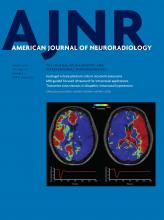Abstract
BACKGROUND AND PURPOSE: Endovascular flow diverters are increasingly used for the treatment of cerebral aneurysms. We assessed the safety and efficacy of the Flow-Redirection Endoluminal Device (FRED) in a consecutive series of 50 patients.
MATERIALS AND METHODS: Inclusion criteria were wide-neck, blister-like, or fusiform/dissecting aneurysms independent of size, treated with the FRED between February 2014 and May 2015. Assessment criteria were aneurysm occlusion, manifest ischemic stroke, bleeding, or death. The occlusion rate was assessed at 3 months with flat panel CT and at 6 months with DSA by using the Raymond classification and the O'Kelly-Marotta grading scale.
RESULTS: Fifty patients with 52 aneurysms were treated with 54 FREDs; 20 patients were treated with the FRED and coils. Aneurysm size ranged from 2.0 to 18.5 mm. Deployment of the FRED was successful in all cases. There were no device-associated complications. One patient developed mild stroke symptoms that fully receded within days. There have been no late-term complications so far and no treatment-related mortality. Initial follow-up at 3 months showed complete occlusion in 72.3% of the overall study group, Six-month follow-up showed total and remnant-neck occlusion in 87.2% of patients, distributed over 81.5% of the FRED-only cases and 95.0% of the cases with combined treatment.
CONCLUSIONS: The FRED flow diverter is a safe device for the treatment of cerebral aneurysms of various types. Our data reveal high occlusion rates at 3 and 6 months, comparable with those in other flow diverters. Long-term occlusion rates are expected.
ABBREVIATIONS:
- FPCT
- flat panel CT
- FRED
- Flow-Redirection Endoluminal Device
- RROC
- Raymond-Roy occlusion classification
- © 2017 by American Journal of Neuroradiology












